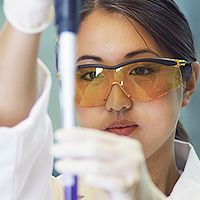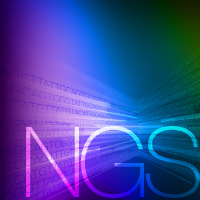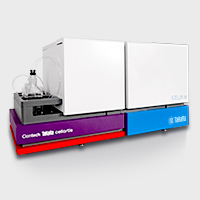This ICELL8 cx Single-Cell System protocol allows for the generation of nuclei preps that are sufficient for single-nuclei sequencing. Our nuclei isolation protocol has been validated for use on suspension (K-562, Jurkat, and GM12878) and adherent (ES, NIH 3T3, and HEK293T) cell lines.
User-generated protocol
Protocol: Nuclei isolation from mammalian cells
Introduction
Protocol
A. Prior to isolation
- Prepare 10 ml of Nuclei Isolation Lysis Reagent (NILR) as follows, and store at 4°C:
100.0 µl Tris-HCl, pH 7.5 (1 M) 33.3 µl NaCl (3 M) 30.0 µl MgCl2 (1 M) 100.0 µl TERGITOL solution (10%) (Millipore-Sigma, Cat. # NP40S-100ML) 9,736.7 µl H2O (Molecular biology grade) 10.0 ml Total volume NOTE: TERGITOL is highly viscous, so you may wish to use a positive displacement pipette to ensure accurate pipetting. TERGITOL will take some time to settle into solution; do not vortex to speed up this process as this will cause heavy foaming of the NILR.
- Starting with approximately 1 x 106 cells/ml, prepare a 1:1 mixture of Hoechst 33342 and propidium iodide (PI) dyes by adding 80 µl of each dye (160 µl total) per 1 ml of cells to be stained. Protect this mixture from light until it is ready for use.
B. Stain and count cells
NOTE: The protocol below is given for an example volume of 2 ml but may be scaled up or down depending on your experimental needs. All incubation steps in this section may be performed at either 4°C or 37°C, depending on your cell line/preference.
- If you are using suspension cells, skip to Step B.3.
- If you are using adherent cells, you may perform one of the following prior to proceeding to Step B.3:
- Detach cells from their support/dish (e.g., by trypsinization), add complete media to inactivate the trypsin, pipette gently with a large-bore pipette tip to break up clumps of cells, and proceed to steps B.3 and B.4, OR
- Stain cells (in complete media) directly in wells at either 4°C or 37°C, wash with 1X PBS, and then proceed to trypsinization, addition of complete media, pipetting, and to step B.5.
- Transfer ~2.1 ml of cell suspension in media to a fresh 5-ml conical Eppendorf tube. Determine cell concentration using a Moxi Z automated cell counter and a Moxi cassette (refer to the Moxi Z user manual for guidance in selecting an appropriate cassette size for the cells being analyzed). Ensure the cell size gates capture the correct size range or the resulting cell count may not be accurate. Record both the cell concentration and cell-size distribution.
- Add 320 µl of premixed Hoechst 33342 and PI dye mix to the remaining cell suspension. Mix gently by inverting the tube 5 times. Do not vortex or over-agitate the cells.
- Incubate cells at either 4°C or 37°C for 20 min. During this time, prewarm 1X PBS to 37°C.
- Add 2 ml of prewarmed 1X PBS to stained cells. Mix by gently inverting the tube 5 times. Do not vortex or over-agitate the cells.
- Pellet the cells in a 5-ml conical Eppendorf tube by centrifuging at 300g for 5 min at either 4°C or room temperature. You should see a firm pellet of cells.
C. Isolate nuclei
- Resuspend the pellet from Step B.7 in 1 ml of NILR (prepared in Step A.1). Mix well to make a homogenous mixture.
NOTE: If you are using a cell type that has not been validated by this protocol, your sample may require an incubation period at this step.
- Centrifuge cells at 300g for 10 min at either room temperature or 4°C as per the recommended guidelines for working with your specific cell type(s).
- Remove and discard the supernatant.
- Resuspend the pellet in 1X PBS by vigorously and repeatedly pipetting to dissociate clumps. We recommend resuspending cells in a 1-ml volume, but your resuspension volume may vary depending on your desired end concentration.
- Using a Moxi Z automated cell counter, take two readings of cell-size distribution and cell fluorescence, and average the readings. Record the cell-size distribution and Hoechst 33342/PI fluorescence intensities.
NOTE: Ensure the cell size gates capture the correct cell-size range or the resulting cell count may not be accurate.
- Compare the size distribution of the whole cells to that of the nuclei (see sample data figure). Nuclei sizes may be noticeably smaller than those of intact cells (in some cases, one-third to one-half the size of whole cells).
NOTE: Nuclei yields are typically ~60% of the starting cell count. Your results may vary depending on the cell type(s) used.
Sample data


Comparison of whole cell- vs nuclei-size distribution of suspension and adherent cell lines. Cell-size distribution ranges were collected from three suspension (Panel A) and three adherent (Panel B) cell lines prior to lysis (whole cells) and after lysis (nuclei). All samples tested showed marked reductions in size following lysis, consistent with the recovery of nuclei.

User-generated protocols
User-generated protocols are based on internal proof-of-concept experiments, customer collaborations, and published literature. In some cases, relevant results are discussed in our research news BioView blog articles. While we expect these protocols to be successful in your hands, they may not be fully reviewed or optimized. We encourage you to contact us or refer to the published literature for more information about these user-generated and -reported protocols.
If you are looking for a product-specific, fully optimized User Manual or Protocol-At-A-Glance, please visit the product's product page, open the item's product details row in the price table, and click Documents. More detailed instructions for locating documents are available on our website FAQs page.
Questions? Protocols of your own that you would like to share?
Contact technical support Give feedbackTakara Bio USA, Inc.
United States/Canada: +1.800.662.2566 • Asia Pacific: +1.650.919.7300 • Europe: +33.(0)1.3904.6880 • Japan: +81.(0)77.565.6999
FOR RESEARCH USE ONLY. NOT FOR USE IN DIAGNOSTIC PROCEDURES. © 2025 Takara Bio Inc. All Rights Reserved. All trademarks are the property of Takara Bio Inc. or its affiliate(s) in the U.S. and/or other countries or their respective owners. Certain trademarks may not be registered in all jurisdictions. Additional product, intellectual property, and restricted use information is available at takarabio.com.





